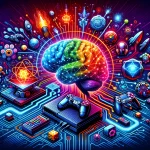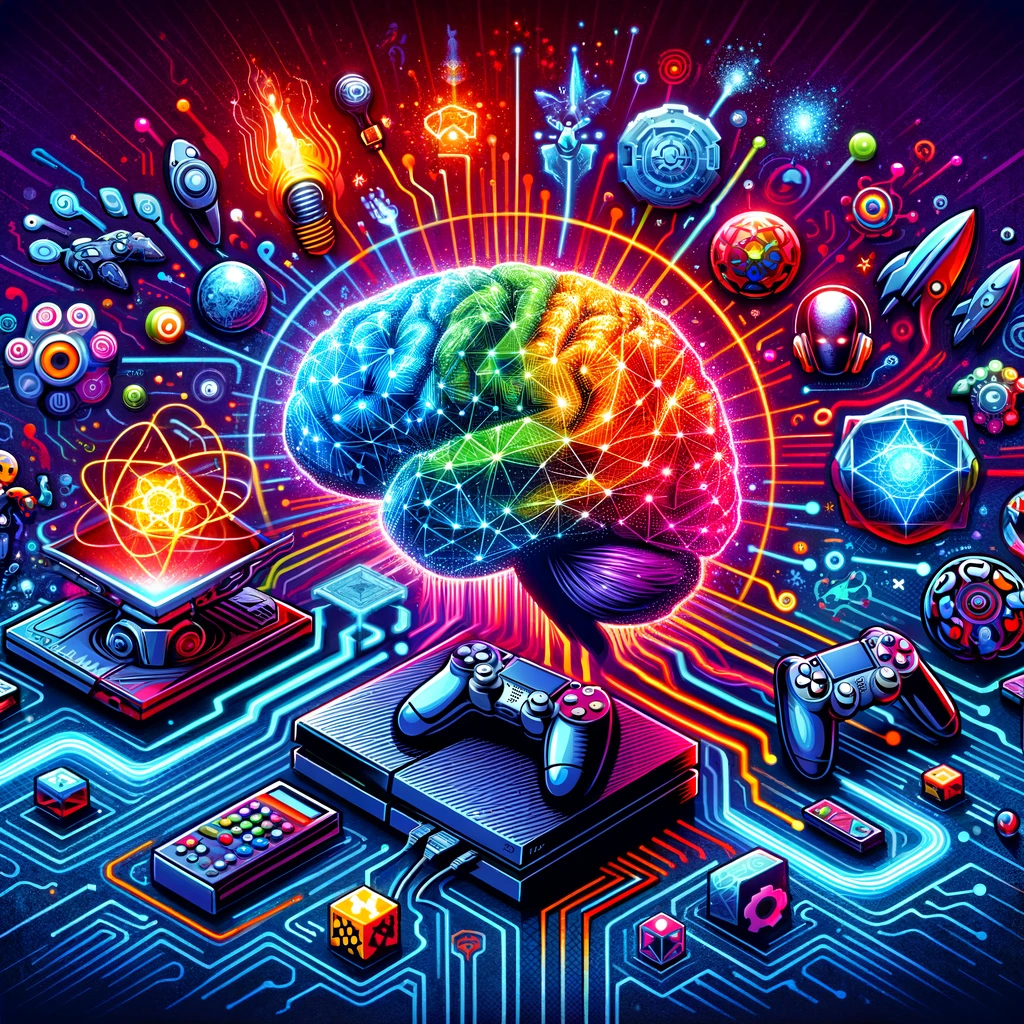The gaming industry has undergone a remarkable transformation with the integration of artificial intelligence (AI). This cutting-edge technology has revolutionized gameplay, graphics, and player experience, taking gaming to a whole new level. AI has evolved from simply rendering pixels on a screen to providing intelligent and immersive gaming experiences.
One of the significant impacts of AI in gaming is the creation of AI-powered game characters. With the help of sophisticated AI algorithms, non-player characters (NPCs) in games are no longer mere scripted entities. They have become intelligent beings that adapt, learn, and interact with players in realistic and dynamic ways. These AI-driven NPCs can analyze player behavior, make decisions based on their surroundings, and even learn from their mistakes, making the gaming experience more challenging and engaging.
Furthermore, AI has played a pivotal role in enhancing graphics and realism in games. Through machine learning and neural networks, AI techniques have been employed to improve graphics, create realistic environments, and enhance visual effects. The result is stunningly lifelike game worlds that captivate players and immerse them in a truly immersive experience. AI-powered graphics algorithms can generate detailed textures, realistic lighting, and fluid animations, making games visually stunning and visually appealing.
Another remarkable application of AI in gaming is procedural content generation. AI algorithms can generate game content such as levels, maps, and quests, providing endless possibilities and unique experiences for players. This technology allows game developers to create vast and diverse game worlds without the need for manual design, saving time and resources. Procedural content generation ensures that each playthrough is different, keeping players engaged and excited to explore new challenges and adventures.
AI also plays a crucial role in analyzing player behavior and preferences. By analyzing vast amounts of data, AI algorithms can understand player preferences, play styles, and habits. Game developers can leverage this information to personalize gameplay, offer tailored recommendations, and create more engaging experiences. AI-powered recommendation systems can suggest suitable game modes, difficulty levels, and even in-game purchases based on individual player preferences, enhancing the overall gaming experience.
Furthermore, AI is instrumental in game design and testing processes. It automates various tasks, optimizes game mechanics, and ensures high-quality gameplay for players. AI algorithms can simulate and predict player interactions, allowing developers to fine-tune game mechanics and balance difficulty levels. Additionally, AI-powered testing tools can identify bugs, glitches, and performance issues, ensuring that games are polished and optimized before release.
In conclusion, AI has transformed the gaming industry by revolutionizing gameplay, graphics, and player experience. From intelligent NPCs to enhanced graphics, procedural content generation to player behavior analysis, and game design to testing, AI has become an integral part of the gaming ecosystem. As AI continues to advance, we can expect even more exciting and immersive gaming experiences in the future.
AI-powered Game Characters
AI-powered game characters have revolutionized the gaming industry, taking gameplay, graphics, and player experience to a whole new level. With the use of AI algorithms, game developers are able to create intelligent non-player characters (NPCs) that adapt, learn, and interact with players in realistic and dynamic ways.
These AI-powered NPCs are no longer just scripted entities that follow a predetermined set of actions. They have the ability to make decisions based on the player’s actions and adapt their behavior accordingly. This creates a more immersive and challenging gaming experience, as players are faced with intelligent opponents that can learn and evolve throughout the game.
AI algorithms analyze player behavior and preferences, allowing game developers to personalize gameplay and offer tailored recommendations. This means that the AI-powered game characters can provide a unique experience for each player, adapting the game to their playing style and preferences.
Furthermore, AI-powered game characters can also enhance the social aspect of gaming. They can interact with players in a more natural and realistic way, creating a sense of immersion and connection. This opens up new possibilities for cooperative gameplay and multiplayer experiences, where players can team up with AI-controlled companions.
In terms of graphics, AI techniques such as machine learning and neural networks are used to improve visual effects and create realistic environments. AI algorithms can generate detailed textures, realistic physics, and lifelike animations, making the gaming experience more visually appealing and immersive.
In conclusion, AI-powered game characters have transformed the gaming industry by bringing intelligence, adaptability, and realism to gameplay. With AI algorithms, game developers are able to create NPCs that learn, interact, and adapt to players’ actions, providing a more immersive and challenging experience. Additionally, AI techniques enhance graphics, creating realistic environments and visual effects. The future of gaming is undoubtedly shaped by AI, as it continues to push the boundaries of what is possible in the gaming world.
Enhanced Graphics and Realism
The world of gaming has come a long way since the days of pixelated graphics and simple gameplay. Thanks to the advancements in artificial intelligence (AI), games now offer enhanced graphics and realism that immerse players in a whole new level of gaming experience.
AI techniques such as machine learning and neural networks have revolutionized the way graphics are created in games. These algorithms can analyze vast amounts of data and learn from it to generate stunning visuals and realistic environments. From lifelike character models to breathtaking landscapes, AI-powered graphics bring games to life like never before.
But AI doesn’t stop at just improving the visuals. It also enhances the overall realism of the gameplay. AI algorithms can simulate real-world physics, allowing objects to move and interact with each other in a natural and believable manner. Whether it’s the way a character jumps, the way a car handles on the road, or the way a ball bounces, AI ensures that every action in the game feels authentic and immersive.
Moreover, AI is also used to create realistic facial expressions and emotions for characters. Through facial recognition technology and emotion detection algorithms, game characters can now display a wide range of emotions, making the interactions between players and NPCs more engaging and lifelike.
With AI-powered graphics and realism, players can truly feel like they are stepping into another world. The level of detail and immersion provided by AI algorithms elevates the gaming experience to new heights, keeping players hooked and coming back for more.
Procedural Content Generation
Procedural Content Generation is a fascinating aspect of the gaming industry that has been revolutionized by artificial intelligence (AI). With AI algorithms at work, game developers can now generate game content such as levels, maps, and quests in a procedural and automated manner. This not only provides endless possibilities for players but also ensures unique and personalized experiences.
Through the use of AI, game developers can create games that offer a dynamic and ever-changing environment. AI algorithms analyze various parameters such as player preferences, game mechanics, and level design to generate content that is tailored to the individual player. This means that each player will have a different experience, making the game more engaging and immersive.
One of the key advantages of procedural content generation is its ability to create vast and complex game worlds. AI algorithms can generate intricate landscapes, detailed environments, and challenging quests, all without the need for manual input from developers. This not only saves time and resources but also allows for the creation of larger and more expansive game worlds.
Furthermore, procedural content generation allows for the creation of content that is not limited by human imagination. AI algorithms can generate unexpected and surprising elements within the game, keeping players on their toes and adding an element of excitement. Whether it’s discovering hidden treasure in an unexplored area or encountering a unique and challenging enemy, procedural content generation adds a layer of unpredictability to the gaming experience.
In conclusion, procedural content generation powered by AI has transformed the gaming industry by providing endless possibilities, personalized experiences, and unexpected surprises. It has not only revolutionized the way games are created but also enhanced player engagement and immersion. As AI continues to advance, we can expect even more exciting developments in the field of procedural content generation, taking gaming to new heights.
Player Behavior Analysis
Player behavior analysis is a game-changing aspect of the gaming industry that utilizes artificial intelligence (AI) to gain insights into how players interact with games. By analyzing player behavior and preferences, game developers can create personalized gameplay experiences, offer tailored recommendations, and ultimately create more engaging games.
AI algorithms are used to collect and analyze vast amounts of data generated by players. This data includes information such as player actions, choices, and preferences. By analyzing this data, AI can identify patterns and trends, allowing game developers to understand player behavior on a deeper level.
One way player behavior analysis is used is in creating personalized gameplay experiences. AI algorithms can analyze a player’s actions and preferences to dynamically adjust the difficulty level of a game, ensuring that players are consistently challenged but not overwhelmed. This personalized approach enhances the player’s experience by providing a game that adapts to their skill level and playing style.
Additionally, player behavior analysis can be used to offer tailored recommendations to players. By understanding a player’s preferences, AI algorithms can suggest games, levels, or in-game items that are likely to appeal to the player. This not only enhances the player’s experience by offering content that aligns with their interests but also increases player engagement and satisfaction.
Moreover, player behavior analysis can help game developers make informed decisions about game design and updates. By analyzing player behavior, developers can identify which aspects of a game are popular and well-received, and which may need improvement. This data-driven approach allows for more effective game design and ensures that games are optimized to meet the needs and preferences of the players.
In conclusion, player behavior analysis powered by AI is revolutionizing the gaming industry. By analyzing player data, game developers can create personalized gameplay experiences, offer tailored recommendations, and make informed decisions about game design. This not only enhances the player’s experience but also drives engagement and satisfaction, ultimately shaping the future of gaming.
AI in Game Design and Testing
AI plays a crucial role in game design and testing, revolutionizing the way games are created and ensuring high-quality gameplay for players. With the help of AI algorithms and techniques, game developers can automate various tasks, optimize game mechanics, and create engaging experiences.
One of the key applications of AI in game design is procedural generation. AI algorithms can generate game content such as levels, maps, and quests, providing endless possibilities and unique experiences for players. This not only saves time and resources for game developers but also adds a sense of novelty and exploration for players.
In addition to content generation, AI is also used in game testing. AI-powered bots can simulate player behavior and interactions, allowing developers to identify and fix bugs, glitches, and balance issues. This automated testing process helps ensure that the game functions smoothly and provides a seamless experience to players.
Furthermore, AI can optimize game mechanics by analyzing player data and behavior. By understanding how players interact with the game, AI algorithms can suggest improvements and adjustments to enhance gameplay. This includes fine-tuning difficulty levels, balancing character abilities, and refining game progression, ultimately creating a more enjoyable and immersive experience for players.
Overall, AI in game design and testing brings efficiency, innovation, and quality to the gaming industry. It enables developers to create unique and dynamic game experiences, while also ensuring that players have a seamless and engaging gameplay. With the continuous advancements in AI technology, we can expect even more exciting and immersive games in the future.






